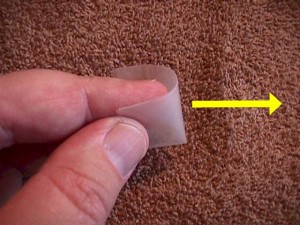Contraceptive vaginal film is available for use as either a primary method of contraception or to increase the effectiveness of other methods, such as condoms.
Each film is a semi-transparent square of a dissolvable material containing nonoxynol-9, a standard spermicide.

After opening the individual film wrapper, the film is removed and folded once in half. Use dry fingers; otherwise the film will being to melt and will become unmanageable.
The film is then folded in half once again and folded over the index or middle finger. Push the folded film deep into the vagina so that it is up against the cervix.
After insertion, the film needs 15 minutes to melt to form an effective spermicidal barrier. Once in place, it is effective for up to one hour after insertion. If additional intercourse is performed, an additional film should be inserted.
The film dissolves completely and does not need to be removed. It will be discharged over time with the normal vaginal secretions and body fluids. If douching is desired, it should not be done during the first 6 hours after intercourse as some of the contraceptive protection may be lost.
Because the active ingredient is nonoxynol-9, some individuals (up to 20% of the population) will be sensitive to it and experience a burning sensation during use. Those individuals should not continue to use this method of contraception and should seek another alternative.
Effectiveness of the film is probably similar to that of the diaphragm. If used carefully and consistently, about 5 women out of 100 will become pregnant each year, despite the use of contraceptive vaginal film. For the average user, failure rates are likely higher, about 15 or 20% each year.
